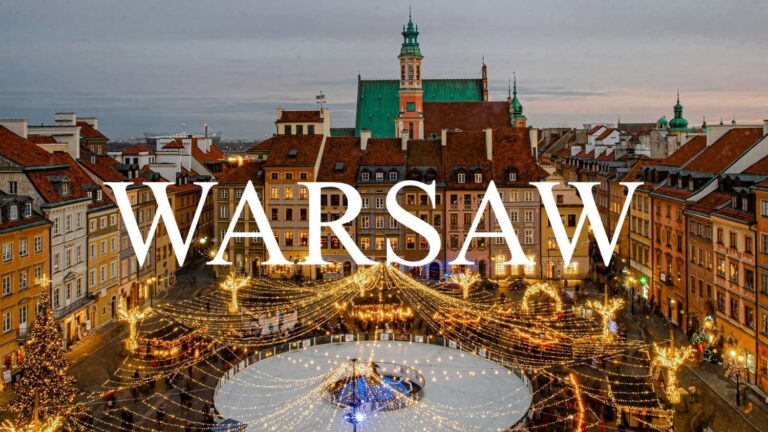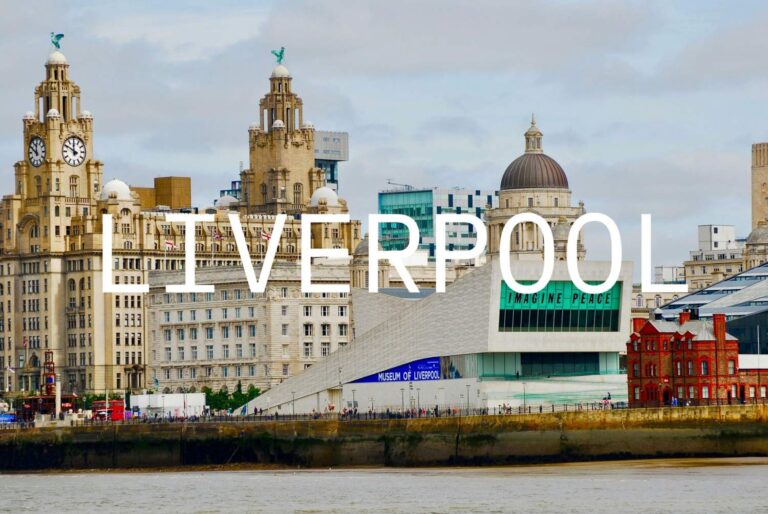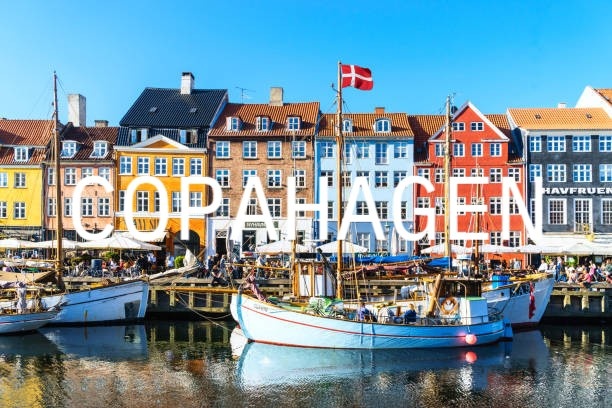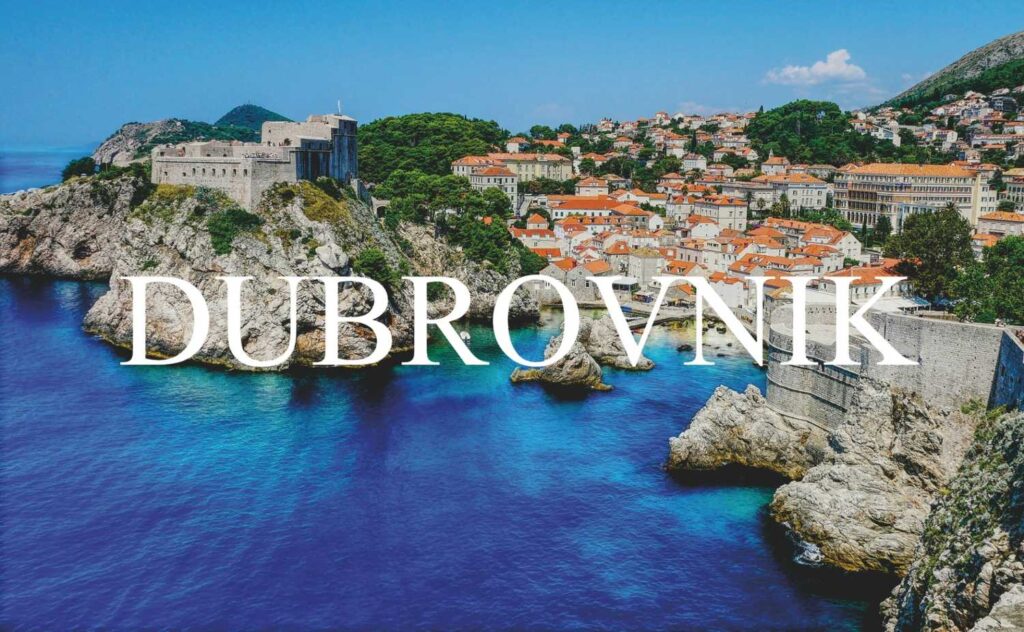
Dubrovnik, often hailed as the “Pearl of the Adriatic,” is one of Croatia’s most enchanting destinations, offering a unique combination of historic grandeur, vibrant culture, and stunning seaside beauty. Situated on the sparkling Adriatic coast, this ancient city has preserved its medieval charm through centuries, making it a living museum of history and architecture. The iconic city walls, stretching nearly two kilometers, invite travelers to walk along their ramparts and take in breathtaking views of terracotta rooftops, majestic forts, and the deep blue sea beyond.
The UNESCO-listed Old Town is a labyrinth of narrow cobbled streets, elegant squares, and charming churches, where every corner reveals stories of Dubrovnik’s rich past as a powerful maritime republic. Key highlights include the Rector’s Palace, Sponza Palace, and the magnificent Dubrovnik Cathedral, each showcasing exquisite Renaissance and Baroque architecture.
Beyond history, Dubrovnik offers a vibrant cultural scene with festivals, art galleries, and lively markets. Food lovers will delight in traditional Dalmatian cuisine served in quaint tavernas and upscale restaurants, where fresh seafood, local olive oils, and wines take center stage.
Nature enthusiasts can explore nearby islands like Lokrum or take boat trips along the stunning coastline, while beachgoers enjoy sunbathing on pebbly shores and swimming in crystal-clear waters. As night falls, the city’s vibrant nightlife comes alive, with cozy bars, elegant lounges, and open-air concerts that add to Dubrovnik’s magical atmosphere.
Whether you’re a history buff, a beach lover, a foodie, or simply seeking a picturesque escape, Dubrovnik offers an unforgettable experience filled with beauty, culture, and warmth — a true gem on the Adriatic that leaves a lasting impression on every traveler.
🌞 Best Time to Visit Dubrovnik
The best time to visit Dubrovnik is from May to September when the weather is warm and sunny, perfect for beach days and sightseeing.
- May and June: Pleasant temperatures and fewer tourists make it ideal for exploring comfortably.
- July and August: Peak summer with vibrant festivals, bustling streets, and lively nightlife—but expect larger crowds and higher prices.
- September: Warm sea and mild weather with thinning crowds, great for a relaxed visit.
If you prefer quieter times, the shoulder seasons (April and October) offer milder weather and fewer visitors, though some attractions may have reduced hours.
💶 Currency and Practical Info
- Currency: Croatian Kuna (HRK)
- Language: Croatian is official, but English is widely spoken in tourist areas.
- Transport: Dubrovnik is walkable, especially the Old Town. Buses connect to nearby beaches and towns.
- Daily Budget:
- Budget travelers: €40–€70/day
- Mid-range: €70–€150/day
- Luxury: €150+/day
🌟 Top 10 Best Places to Visit in Dubrovnik
Dubrovnik City Walls
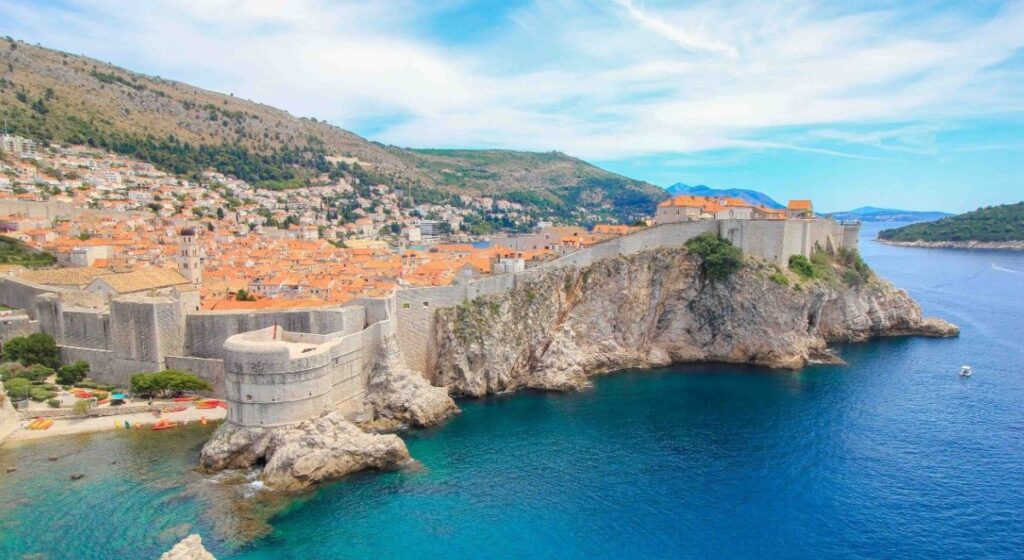
Encircling the stunning Old Town of Dubrovnik, Croatia, the Dubrovnik City Walls stand as one of the most impressive and well-preserved fortification systems in Europe. These ancient stone walls, stretching nearly 2 kilometers, have guarded the city for centuries and now offer visitors spectacular views over terracotta rooftops, the shimmering Adriatic Sea, and historic landmarks. Walking the walls is a must-do experience that combines history, culture, and breathtaking scenery.
🌟 Highlights of Dubrovnik City Walls
• 🏰 Historic Fortifications
Explore massive towers, bastions, and forts built between the 12th and 17th centuries, including the Minceta Tower, Fort Bokar, and Revelin Fortress, each with its own unique story.
• 🌅 Panoramic Views
Enjoy unrivaled views of Dubrovnik’s Old Town, red-tiled roofs, and the deep blue Adriatic coastline—a photographer’s paradise at sunrise or sunset.
• 🎬 Game of Thrones Filming Locations
Fans of the hit series will recognize many iconic scenes filmed along the walls, adding a pop culture twist to your visit.
• 🏞️ Stroll with History
The walls offer a scenic 1.9-kilometer walk that immerses you in Dubrovnik’s medieval past, with informative plaques and guided tour options available.
🚗 How to Get There
• In the City Center:
The entrance to the city walls is conveniently located near the Pile Gate and Ploče Gate, both easily accessible by foot within Dubrovnik’s Old Town.
🕒 Visitor Information
• Opening Hours:
Open daily, with hours varying seasonally—generally from 8:00 AM to sunset.
• Entry Fee:
Tickets cost around €30 for adults, with discounts for children, students, and seniors.
• Recommended Visit Duration:
Allocate 1.5 to 2 hours to comfortably walk the walls and take in all the sights.
💡 Travel Tips
• 👟 Wear Comfortable Shoes:
The walls have uneven stone steps and can be steep in places.
• 🧴 Bring Sun Protection:
The walk is exposed, so sunscreen, hats, and water are essential, especially in summer.
• 🎟️ Buy Tickets Online in Advance:
To avoid queues, especially during peak tourist season.
• 📷 Capture the Views:
Bring a camera or smartphone for stunning panoramic shots.
Walking the Dubrovnik City Walls is an unforgettable experience that offers a perfect blend of history, architecture, and spectacular coastal views. It’s a journey through time that lets you feel the spirit of this Adriatic gem from a truly unique vantage point.
Stradun (Placa)
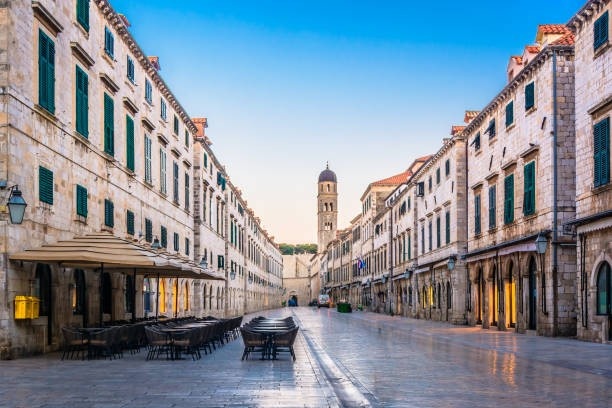
Stradun, also known as Placa, is the grand limestone-paved main street running through the historic Old Town of Dubrovnik, Croatia. This bustling promenade is more than just a street—it’s the vibrant social and cultural spine of the city, framed by centuries-old buildings and lined with cafés, shops, and landmarks. Walking along Stradun is like stepping into a living postcard, where history meets daily life under the warm Adriatic sun.
🌟 Highlights of Stradun (Placa)
• 🏛️ Stately Architecture
Flanked by elegant Renaissance and Baroque buildings, Stradun showcases Dubrovnik’s rich architectural heritage, rebuilt after the 1667 earthquake with uniform stone façades and graceful arches.
• ⛪ Church of St. Blaise
Located just off Stradun, this beautiful Baroque church honors Dubrovnik’s patron saint and features exquisite interior artwork and sculptures.
• ⏰ Onofrio’s Fountain
A historic circular fountain at the eastern end of Stradun, originally part of Dubrovnik’s medieval water supply system and a popular meeting spot for locals and visitors.
• 🛍️ Shops and Cafés
From boutique stores selling local crafts to cozy cafés and ice cream parlors, Stradun is perfect for leisurely shopping, dining, or people-watching.
• 🎭 Festivals & Events
Stradun is the stage for many city celebrations, including the Dubrovnik Summer Festival, with open-air concerts, theatrical performances, and cultural parades.
• 🌅 Sunset Strolls
The broad, open street is ideal for a romantic walk as the sun sets, with golden light reflecting on the polished limestone.
🚗 How to Get There
• On Foot:
Stradun is pedestrian-only and easily accessible from all entrances to Dubrovnik’s Old Town.
• Public Transport & Parking:
Visitors typically park outside the Old Town and enter on foot; shuttle buses and taxis are available.
🕒 Visitor Information
• Best Time to Visit:
Spring (April–June) and early fall (September–October) offer pleasant weather and fewer tourists.
• Entry Fees:
Walking Stradun is free; some nearby attractions may have entrance fees.
• Recommended Visit Duration:
1–2 hours to stroll, shop, and soak up the atmosphere; longer if including nearby sites.
💡 Travel Tips
• 👟 Wear Comfortable Shoes:
The smooth limestone is easy to walk on, but comfortable footwear is recommended for extended exploring.
• 📸 Capture the Vibe:
Early morning and late afternoon offer beautiful lighting and fewer crowds for photos.
• 🍦 Try Local Treats:
Stop by a gelateria or café to enjoy local specialties like Dubrovnik ice cream or fresh pastries.
Stradun (Placa) is the shining artery of Dubrovnik’s Old Town—where history, culture, and daily life flow together seamlessly. Whether you’re admiring its historic fountains, savoring a coffee, or simply soaking in the vibrant street life, Stradun offers an unforgettable experience at the heart of this stunning Adriatic city.
Fort Lovrijenac
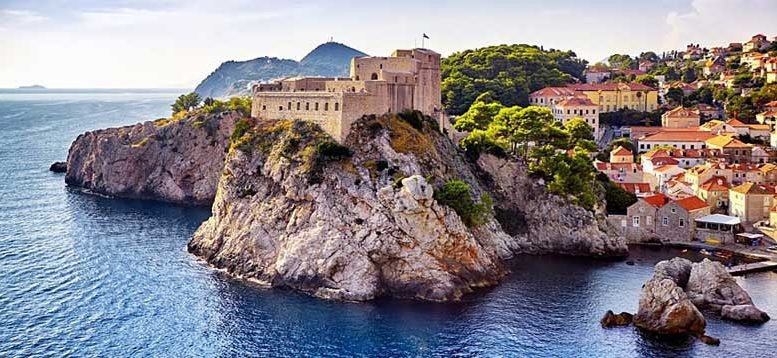
Perched dramatically on a 37-meter-high cliff just outside Dubrovnik’s western city walls, Fort Lovrijenac is a stunning medieval fortress that has played a crucial role in protecting the city for centuries. Often called the “Gibraltar of Dubrovnik,” this imposing fort not only offers incredible panoramic views of the Adriatic Sea and Dubrovnik’s Old Town but also embodies the city’s resilient spirit and rich history. Today, it stands as both a symbol of defense and a cultural venue, making it a must-visit attraction.
🌟 Highlights of Fort Lovrijenac
• 🏰 Historic Architecture
Built in the early 11th century, the fortress features massive stone walls up to 12 meters thick and a triangular shape designed for defense. Its strategic location made it nearly impregnable and key in defending Dubrovnik from Venetian and Ottoman attacks.
• 🌊 Breathtaking Views
From the ramparts, enjoy sweeping views of the sparkling Adriatic Sea, the city’s iconic red rooftops, and the surrounding landscape—a perfect spot for photography enthusiasts.
• 🎭 Cultural Hub
Fort Lovrijenac hosts open-air theatrical performances, including Dubrovnik’s famous summer Festival of Drama and Shakespeare plays, adding a lively cultural dimension to its historic atmosphere.
• ⚔️ Legendary Inscription
Look for the famous Latin inscription above the fort’s entrance: “Non Bene Pro Toto Libertas Venditur Auro” — “Freedom is not sold for all the gold in the world,” reflecting Dubrovnik’s fierce independence.
🚶♂️ How to Get There
• Located just outside Dubrovnik’s west city walls, the fort is a short, scenic walk from the Pile Gate entrance to the Old Town. Follow the signs or take a guided tour for a richer experience.
🕒 Visitor Information
• Opening Hours:
Open daily, usually from 9:00 AM to 6:00 PM, with extended hours in summer.
• Entry Fee:
Admission costs around €8–€10, with discounts for students and seniors. Combined tickets with city walls are often available.
• Recommended Visit Duration:
Plan for about 1 hour to explore the fort, take in views, and enjoy any ongoing performances.
💡 Travel Tips
• 👟 Wear Comfortable Shoes:
The path includes uneven steps and rocky surfaces.
• 🧴 Sun Protection:
The fort is exposed with limited shade, so bring sunscreen and a hat.
• 🎟️ Check for Events:
Try to catch a live performance during your visit for a truly unique experience.
• 📸 Bring a Camera:
Capture the stunning vistas and architectural details.
Fort Lovrijenac is more than just a fortress — it’s a powerful symbol of Dubrovnik’s history, resilience, and cultural vibrancy. Whether you’re a history buff, a photography lover, or a theater enthusiast, a visit here offers an unforgettable blend of breathtaking views and rich heritage.
Lokrum Island

Nestled a short ferry ride from the historic walls of Dubrovnik, Lokrum Island is a lush, tranquil oasis offering a perfect blend of natural beauty, history, and relaxation. Known for its dense Mediterranean vegetation, peacocks roaming freely, and crystal-clear waters, Lokrum provides a refreshing contrast to the bustling Old Town. Whether you’re hiking through botanical gardens, exploring ancient ruins, or soaking up the sun on rocky beaches, Lokrum Island invites visitors to unwind amid nature and heritage.
🌟 Highlights of Lokrum Island
• 🌿 Botanical Gardens
Wander through beautiful gardens featuring exotic plants, towering palms, and fragrant Mediterranean flora cultivated since the 19th century.
• 🏰 Fort Royal Fortress
Explore this 19th-century Austro-Hungarian fort perched on the island’s highest point, offering panoramic views of Dubrovnik and the Adriatic Sea.
• 🏝️ Beaches & Swimming Spots
Relax or swim in secluded coves and rocky beaches, including the popular Dead Sea—a small saltwater lake perfect for a refreshing dip.
• 🦚 Peacocks and Wildlife
Encounter free-roaming peacocks and rabbits that add charm and vibrancy to the island’s peaceful trails.
• 🕍 Monastery & Benedictine Ruins
Visit the 11th-century Benedictine monastery ruins and its church, a testament to Lokrum’s historical and spiritual significance.
• 🎨 Cultural Events
Lokrum occasionally hosts open-air concerts, art exhibitions, and cultural festivals in its idyllic setting.
🚗 How to Get There
• By Ferry:
Regular ferries depart from Dubrovnik’s Old Town harbor, with a short 10–15 minute ride. Ferries run frequently during the tourist season.
🕒 Visitor Information
• Best Time to Visit:
Late spring to early fall (May–September) is ideal for swimming, hiking, and enjoying outdoor activities.
• Entry Fees:
There is a small entrance fee to the island (~30 HRK / €4), which helps maintain the park and facilities.
• Recommended Visit Duration:
3–5 hours allows time to explore gardens, ruins, beaches, and enjoy a picnic or café visit.
💡 Travel Tips
• 👟 Wear Comfortable Shoes:
Trails can be rocky and uneven; sturdy walking shoes or sandals are recommended.
• 🧴 Bring Sun Protection & Water:
Shade can be limited, so sunscreen, hats, and hydration are essential.
• 🥪 Pack a Picnic:
Food options on the island are limited; bringing snacks or a picnic enhances the experience.
• 📸 Don’t Forget Your Camera:
Lokrum’s scenic views, wildlife, and historic sites offer fantastic photo opportunities.
Lokrum Island is a serene retreat that perfectly complements the vibrant energy of Dubrovnik. Its rich mix of nature, history, and peaceful beaches offers visitors a unique chance to relax and explore just minutes from the city’s historic center—a little paradise on the Adriatic coast.
Mount Srđ
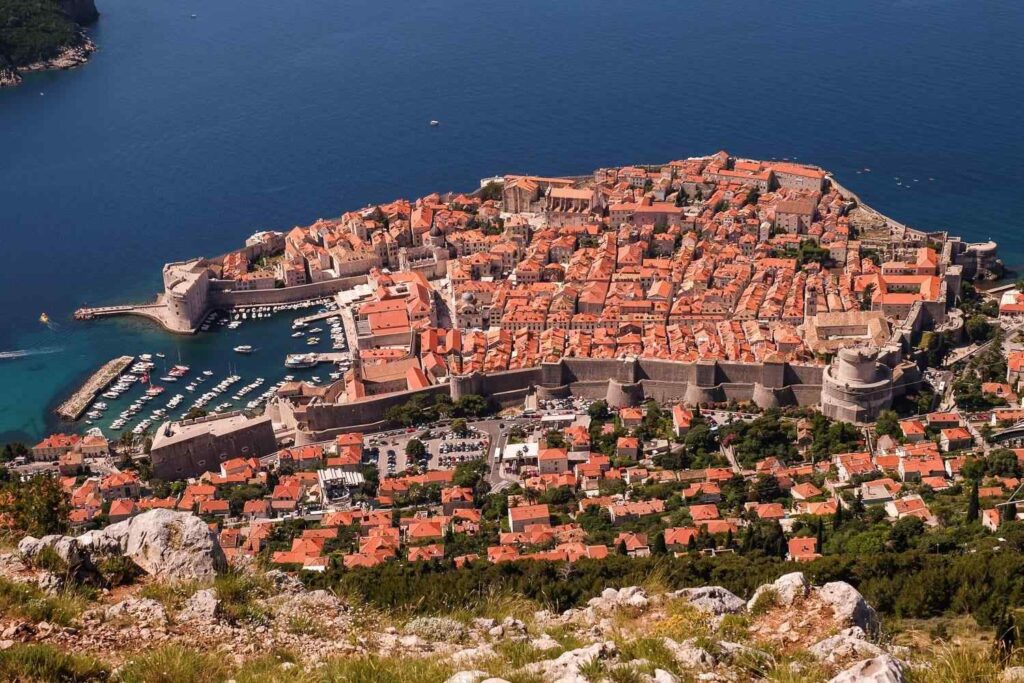
Rising 412 meters (1,352 feet) above the historic city of Dubrovnik, Mount Srđ offers one of the most spectacular vantage points in the region. This rugged hill provides breathtaking panoramic views of Dubrovnik’s Old Town, the sparkling Adriatic Sea, and the surrounding islands. Beyond its natural beauty, Mount Srđ is steeped in history, including its role in the Croatian War of Independence, making it a must-visit destination for travelers seeking both scenic beauty and cultural insight.
🌟 Highlights of Mount Srđ
• 🚡 Cable Car Ride
Take the popular cable car from Dubrovnik’s Ploče Gate to the summit for a quick and scenic ascent. The ride itself offers stunning views and photo opportunities.
• 🏞️ Panoramic Viewing Points
At the top, enjoy 360-degree views encompassing Dubrovnik’s red-tiled roofs, the shimmering Adriatic, and nearby islands such as Lokrum and the Elaphiti archipelago.
• 🏰 Fort Imperial
Explore Fort Imperial, a 19th-century fortress perched on the summit, which played a significant role during the 1991 Siege of Dubrovnik. The fort now houses a museum detailing the city’s recent history.
• 🥾 Hiking Trails
For outdoor enthusiasts, several hiking paths lead up to the summit, offering a rewarding challenge and immersive nature experience.
• 🍽️ Restaurants and Cafés
Enjoy a meal or a refreshing drink at the hilltop restaurant while soaking in the breathtaking scenery.
🚗 How to Get There
• Cable Car:
The cable car station is located near Dubrovnik’s Old Town, close to Ploče Gate.
• By Car or Taxi:
Drive or take a taxi up the winding road to the summit—parking is available near the fort and restaurant.
• Hiking:
For the adventurous, hiking trails begin from various points around Dubrovnik.
🕒 Visitor Information
• Cable Car Hours:
Typically open daily from 9:00 AM to sunset; times vary seasonally.
• Entry Fees:
Round-trip cable car tickets cost about €20 for adults; discounts apply for children and seniors. Entrance to Fort Imperial is usually included or charged separately (~€5).
• Recommended Visit Duration:
Plan 1.5 to 2 hours to enjoy the views, explore the fort, and relax at the restaurant.
💡 Travel Tips
• 👟 Wear Comfortable Shoes:
Even if you take the cable car, some walking on uneven surfaces is required.
• 🧴 Bring Sun Protection:
The summit is exposed; sunscreen, sunglasses, and hats are recommended.
• 📷 Charge Your Camera:
The views from Mount Srđ are some of the best for photos in Dubrovnik.
• 🚡 Visit Early or Late:
For fewer crowds and softer lighting, visit early morning or late afternoon.
Mount Srđ is the perfect place to experience Dubrovnik’s breathtaking beauty from above. Whether enjoying a leisurely cable car ride, hiking up the trails, or exploring historic Fort Imperial, this hilltop destination offers unforgettable vistas and a deeper understanding of Dubrovnik’s resilience and charm.
Dubrovnik Cathedral (Assumption Cathedral)

Dominating the skyline of Dubrovnik’s Old Town, the Dubrovnik Cathedral, also known as the Cathedral of the Assumption of the Virgin Mary, is a stunning example of Baroque architecture infused with centuries of history and devotion. Rebuilt after the devastating 1667 earthquake, this magnificent cathedral combines artistic grandeur with spiritual significance, making it a must-visit landmark for those exploring the Adriatic city’s rich heritage.
🌟 Highlights of Dubrovnik Cathedral
• 🏛️ Baroque Architecture
Admire the cathedral’s elegant façade and interior designed by Venetian architect Andrea Buffa, featuring soaring columns, ornate altars, and intricate stucco work.
• 🖼️ Treasury & Artifacts
Explore the cathedral treasury housing a priceless collection of religious relics, including relics of Saint Blaise (the city’s patron saint), medieval paintings, and gold and silver artifacts.
• 🎨 Interior Frescoes & Altarpieces
Marvel at beautifully preserved frescoes and paintings by notable artists, such as Titian and Italian masters, adorning the chapels and main altar.
• 🕍 Crypt & Historical Significance
Visit the crypt beneath the cathedral, containing remains of previous churches and archaeological finds that reveal the site’s long religious history dating back to the 7th century.
• 🎶 Religious Ceremonies & Concerts
Attend special masses, religious festivals, or classical music concerts that occasionally take place in the cathedral, adding to its cultural ambiance.
🚗 How to Get There
• On Foot:
Located in the heart of Dubrovnik’s Old Town, the cathedral is easily reachable by foot from any part of the city center.
🕒 Visitor Information
• Best Time to Visit:
Morning or late afternoon for a quieter, more reflective experience.
• Entry Fees:
Modest admission fee (~20 HRK / €3) for the treasury; entry to the main cathedral is usually free during non-service hours.
• Recommended Visit Duration:
30 minutes to 1 hour to explore the cathedral, treasury, and crypt.
💡 Travel Tips
• 📿 Dress Modestly:
As an active place of worship, visitors should wear respectful clothing (no shorts or sleeveless tops).
• 📸 Photography:
Photos are generally allowed in the main cathedral but restricted in the treasury; check signage.
• 🕯️ Respect Quiet Zones:
Maintain silence and reverence inside the cathedral, especially during services.
Dubrovnik Cathedral is more than an architectural marvel; it’s a living symbol of the city’s resilience, faith, and artistic heritage. From its richly decorated interiors to its sacred relics, the cathedral offers a profound glimpse into Dubrovnik’s spiritual heart and centuries of cultural legacy.
Banje Beach

Just a short stroll from Dubrovnik’s Old Town, Banje Beach is one of the city’s most popular and picturesque beaches. Famous for its crystal-clear turquoise waters and breathtaking views of the historic city walls and the island of Lokrum, Banje offers the perfect blend of relaxation, water activities, and vibrant beachside atmosphere. Whether you’re soaking up the sun, enjoying local cuisine, or taking a refreshing swim, Banje Beach is a must-visit spot for any Dubrovnik traveler.
🌟 Highlights of Banje Beach
• 🌊 Pristine Waters and Sandy-Shingle Shore
The beach features a mix of pebbles and sand with exceptionally clear water, ideal for swimming, snorkeling, and cooling off after exploring the city.
• 🏝️ Stunning Views of Dubrovnik and Lokrum Island
From Banje, enjoy postcard-worthy vistas of the Old Town’s red rooftops, the ancient city walls, and the lush greenery of nearby Lokrum Island.
• 🛶 Water Sports and Activities
Rent paddleboards, kayaks, or pedal boats to explore the coastline, or try jet skiing for an adrenaline rush.
• 🍹 Beach Bars and Restaurants
Several beachside bars and eateries offer refreshing cocktails, light snacks, and local dishes, perfect for a seaside lunch or sunset drink.
• 🌅 Sunset Spot
Banje is an excellent place to watch the sunset, with the historic city bathed in golden light—perfect for romantic moments or stunning photos.
🚶♂️ How to Get There
• Walking:
Banje Beach is about a 10-minute walk east from Dubrovnik’s Old Town main gate (Pile Gate).
• By Boat:
Some boat tours include stops at Banje, or you can rent a private boat to visit.
🕒 Visitor Information
• Opening Hours:
The beach is open year-round, but services like rentals and bars operate mainly from late spring to early fall (May to September).
• Entry Fee:
Access to the beach itself is free, though some facilities like sunbeds and umbrellas may have rental fees (€10–€20).
• Recommended Visit Duration:
Plan 2-3 hours to enjoy swimming, sunbathing, and dining.
💡 Travel Tips
• 👙 Bring Swimwear and Towels:
Essential for enjoying the water and sunbathing.
• 🧴 Sun Protection:
Use sunscreen, sunglasses, and hats—there is limited natural shade.
• 💧 Stay Hydrated:
Drink plenty of water, especially on hot days.
• 🎟️ Reserve Sunbeds in Peak Season:
To secure your spot during busy summer months.
• 📸 Capture the Views:
Don’t forget your camera for spectacular shots of Dubrovnik’s skyline.
Banje Beach offers a perfect seaside escape combined with stunning views of one of Europe’s most beautiful historic cities. It’s the ideal spot to relax after exploring Dubrovnik’s Old Town or to enjoy vibrant beachside fun with friends and family.
Rector’s Palace

Nestled within the maze of Dubrovnik’s Old Town streets, the Rector’s Palace stands as a striking symbol of the city’s political history and architectural evolution. Once the administrative center and residence of the Rector (the head of the Republic of Ragusa), this elegant palace blends Gothic, Renaissance, and Baroque styles, reflecting centuries of change and resilience. Today, it houses a fascinating museum, inviting visitors to step into the world of Dubrovnik’s medieval governance and culture.
🌟 Highlights of Rector’s Palace
• 🏰 Architectural Fusion
Admire the palace’s harmonious blend of Gothic arches, Renaissance windows, and Baroque details, resulting from various rebuilds following earthquakes and fires.
• 🖼️ Cultural History Museum
Explore exhibits showcasing Dubrovnik’s political history, artifacts, weapons, and period furniture that bring the city’s past to life.
• 🏛️ Great Hall & Rector’s Apartments
Visit the elegant halls where the Rector conducted official business and lived, complete with restored frescoes, decorative ceilings, and historic furnishings.
• 🔥 Earthquake Resilience
Learn about the 1667 earthquake’s impact and the palace’s reconstruction efforts, highlighting Dubrovnik’s resilience and dedication to preservation.
• 🎭 Cultural Events
The palace occasionally hosts exhibitions, concerts, and events that celebrate Dubrovnik’s heritage.
🚗 How to Get There
• On Foot:
Located centrally in Dubrovnik’s Old Town, the Rector’s Palace is easily accessible via pedestrian streets and close to other landmarks like Stradun.
🕒 Visitor Information
• Best Time to Visit:
Morning or late afternoon to avoid peak crowds.
• Entry Fees:
Admission is around 100 HRK (~€13) and includes access to the museum and palace interiors.
• Recommended Visit Duration:
1–1.5 hours to thoroughly explore the exhibits and architecture.
💡 Travel Tips
• 🎧 Consider a Guided Tour or Audio Guide:
To fully appreciate the historical context and details, a guided visit or audio guide enhances the experience.
• 📸 Photography:
Photos are usually allowed inside; check for restrictions on flash or tripods.
• 👟 Wear Comfortable Shoes:
The palace floors and stairs can be uneven in places.
The Rector’s Palace is a captivating window into Dubrovnik’s rich political and architectural heritage. Stepping inside offers a journey through the city’s storied past—from its days as a powerful maritime republic to its ongoing legacy as a cultural treasure on the Adriatic coast.
Jesuit Staircase & Church of St. Ignatius
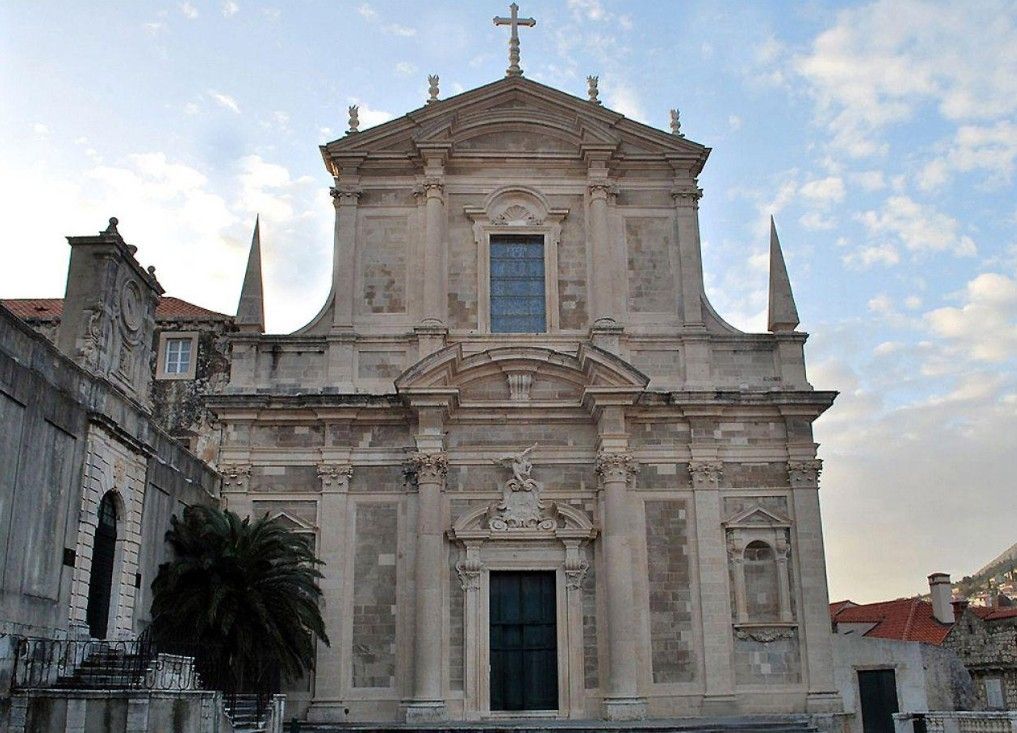
Located within Dubrovnik’s historic Old Town, the Jesuit Staircase and the adjacent Church of St. Ignatius offer a striking blend of architectural elegance and rich history. Known for their dramatic Baroque design, these landmarks have become iconic symbols of the city’s religious and cultural heritage. The staircase gained worldwide fame as a filming location for the hit TV series Game of Thrones, drawing visitors eager to walk in the footsteps of their favorite characters.
🌟 Highlights of Jesuit Staircase & Church of St. Ignatius
• 🏛️ Baroque Architecture
Marvel at the stunning 17th-century Baroque facade of the Church of St. Ignatius, featuring intricate stonework, statues, and grand columns.
• 🌀 The Jesuit Staircase
Climb the broad, steep staircase with over 50 stone steps, framed by balustrades and leading directly to the church’s entrance. The staircase creates a dramatic approach that’s both scenic and cinematic.
• 🎬 Game of Thrones Fame
Recognized as the “Walk of Shame” scene location, the staircase is a must-see for fans of the series and adds a pop culture element to your visit.
• 🎨 Interior Art and Frescoes
Inside the church, admire beautiful frescoes by renowned artists such as Gaetano Garcia, depicting scenes from the life of St. Ignatius and other religious themes.
• 🎶 Music and Events
The church occasionally hosts classical concerts and cultural events, enhancing its vibrant atmosphere.
🚶♂️ How to Get There
• In the Old Town:
The Jesuit Staircase is located near Gundulić Square and is easily accessible on foot from major Old Town landmarks like Stradun and Pile Gate.
🕒 Visitor Information
• Opening Hours:
The church is generally open during daylight hours; check locally for concert schedules.
• Entry Fee:
Entrance to the church is usually free, though donations are welcome.
• Recommended Visit Duration:
Spend about 30 to 45 minutes exploring the staircase and the church interior.
💡 Travel Tips
• 👟 Wear Comfortable Shoes:
The staircase is steep and uneven in parts, so sturdy footwear is advised.
• 📸 Best Photo Spots:
Capture the staircase from the bottom for the full dramatic effect, and don’t miss shots of the church facade from the top.
• 🎟️ Visit Early or Late:
To avoid crowds, especially if you want to experience the site peacefully.
• 🎶 Check for Concerts:
If you’re a music lover, look out for classical performances held inside the church.
The Jesuit Staircase and Church of St. Ignatius perfectly blend architectural grandeur, history, and pop culture in one captivating spot. Whether you’re a history enthusiast, a Game of Thrones fan, or simply looking to admire stunning Baroque art, this Dubrovnik landmark offers a memorable and enriching experience.
💡 Travel Tips for Dubrovnik
- Book your City Walls tickets early to avoid lines, especially in summer.
- Wear comfortable shoes—the Old Town’s cobbled streets and walls require sturdy footwear.
- Try local cuisine like fresh seafood, black risotto, and Dubrovnik’s signature Rozata dessert.
- Visit early or late in the day to enjoy popular spots without crowds and capture the best light for photos.
- Stay hydrated and use sunscreen, especially during the summer months.
🌟 Final Thoughts
Dubrovnik is a city that effortlessly blends history, natural beauty, and vibrant culture. From the soaring city walls to peaceful island escapes, every corner invites discovery and wonder. Whether you’re a history buff, beach lover, or foodie, Dubrovnik promises memories that last a lifetime.

I’m Shreyash Mhashilkar — a full-stack developer by profession, and a passionate explorer of the future at heart.
With a strong foundation in both front-end and back-end , I spend my days building websites and applications that are not just functional, but scalable, intuitive, and user-focused.


